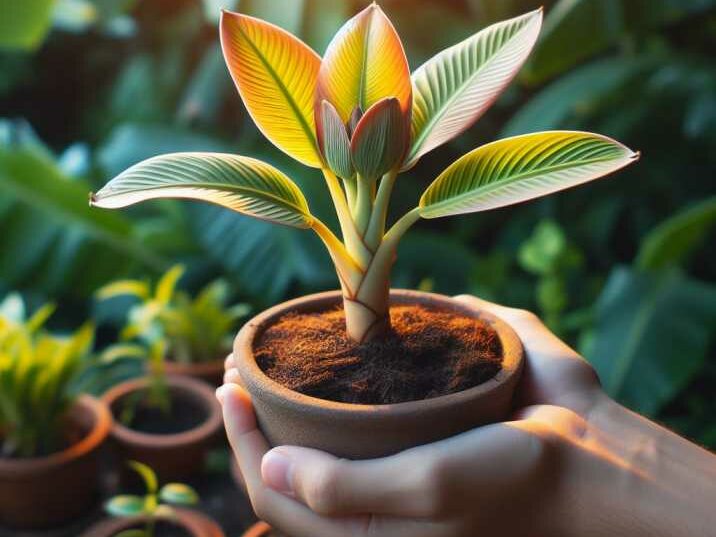Introduction
Table of Contents
Banana plants, with their lush foliage and delicious fruits, are a staple in many gardens and tropical landscapes. However, young banana plants, often referred to as baby banana plants, require special care to ensure healthy growth. One crucial aspect of their care is addressing nutrient deficiencies. In this comprehensive guide, we’ll explore seven effective methods to address nutrient deficiencies in baby banana plants.
Understanding Nutrient Deficiencies in Baby Banana Plants
Before diving into solutions, it’s essential to understand the signs and symptoms of nutrient deficiencies in baby banana plants. Common deficiencies include nitrogen, potassium, magnesium, and iron, which can manifest through yellowing leaves, stunted growth, and poor fruit development.

Soil Testing
The first step in addressing nutrient deficiencies is to conduct a soil test. Soil testing kits are readily available and provide valuable insights into the nutrient levels of your soil. Based on the results, you can adjust the soil pH and nutrient levels accordingly.
Organic Amendments
Organic amendments such as compost, aged manure, and mulch can improve soil fertility and address nutrient deficiencies naturally. Incorporating these amendments into the soil provides a slow-release source of nutrients, promoting healthy growth.
Balanced Fertilization
Choosing the right fertilizer is crucial for addressing specific nutrient deficiencies. Look for fertilizers with a balanced NPK ratio (nitrogen, phosphorus, potassium) tailored to banana plants’ needs. Additionally, consider micronutrient fertilizers to address deficiencies such as iron and magnesium.
Foliar Sprays
Foliar sprays are an effective way to deliver nutrients directly to the leaves of baby banana plants. Choose a high-quality foliar fertilizer containing essential micronutrients such as iron, manganese, and zinc. Regular application according to the manufacturer’s instructions can alleviate nutrient deficiencies and promote vibrant foliage.
Organic Matter Mulching
Mulching with organic matter such as straw, grass clippings, or compost helps retain moisture, suppress weeds, and improve soil structure. As the organic matter decomposes, it releases nutrients into the soil, providing a continuous source of nourishment for baby banana plants.
Companion Planting
Companion planting involves growing complementary plants alongside baby banana plants to enhance soil health and nutrient uptake. Nitrogen-fixing plants like legumes and dynamic accumulators such as comfrey can improve soil fertility and address nutrient deficiencies naturally.
pH Adjustment
Maintaining the proper soil pH is essential for nutrient availability to baby banana plants. Most banana varieties prefer slightly acidic to neutral soils with a pH range of 6.0 to 7.0. Use lime to raise pH or sulfur to lower pH as needed, ensuring optimal nutrient uptake.
Table of Information:
| Method | Description |
|---|---|
| Soil Testing | Conduct soil tests to assess nutrient levels and adjust accordingly. |
| Organic Amendments | Incorporate compost, aged manure, or mulch to improve soil fertility naturally. |
| Balanced Fertilization | Choose fertilizers with a balanced NPK ratio and micronutrient supplements for optimal growth. |
| Foliar Sprays | Apply foliar sprays containing essential micronutrients directly to plant leaves. |
| Organic Matter Mulching | Mulch with organic matter to retain moisture and improve soil structure. |
| Companion Planting | Grow complementary plants alongside banana plants to enhance soil health and nutrient uptake. |
| pH Adjustment | Maintain proper soil pH with lime or sulfur to optimize nutrient availability. |
This comprehensive guide provides effective methods to address nutrient deficiencies in baby banana plants, ensuring healthy growth and abundant fruit production. By implementing these strategies, you can nurture thriving baby banana plants in your garden or landscape.
Conclusion
Addressing nutrient deficiencies in baby banana plants is essential for promoting healthy growth and maximizing fruit production. By implementing these seven effective methods, you can ensure your baby banana plants receive the nutrients they need for robust development. Remember to monitor soil health regularly and adjust nutrient management practices accordingly for thriving banana plants.
Frequently Asked Questions (FAQs)
- How do I know if my baby banana plant has a nutrient deficiency?
- Look for signs such as yellowing leaves, stunted growth, and poor fruit development, which indicate nutrient deficiencies.
- Can I use chemical fertilizers to address nutrient deficiencies in baby banana plants?
- While chemical fertilizers can provide quick fixes, organic amendments and balanced fertilization are recommended for sustainable nutrient management.
- How often should I apply foliar sprays to my baby banana plants?
- Follow the manufacturer’s instructions for application frequency, typically every 2-4 weeks during the growing season.
- Is it necessary to adjust the soil pH for baby banana plants?
- Yes, maintaining the proper soil pH is crucial for optimal nutrient uptake and overall plant health.
- Can companion planting help address nutrient deficiencies in baby banana plants?
- Yes, companion plants like legumes and dynamic accumulators can improve soil fertility and nutrient availability.
- Are there any specific micronutrients that baby banana plants require?
- Yes, micronutrients such as iron, magnesium, and zinc are essential for healthy growth and fruit production in banana plants.
